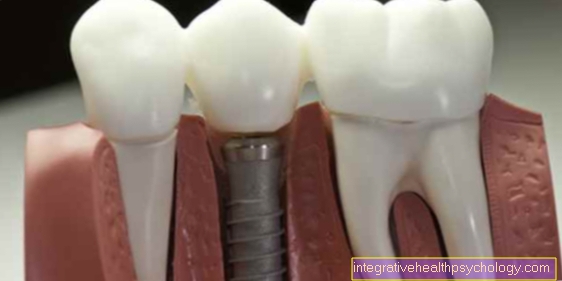Exercise after a broken rib
introduction
Broken ribs are painful and protracted injuries. It usually takes about six weeks to heal, but it can take up to 12 weeks for complicated fractures. Pain can persist until healing is complete. Sport should not be started too early after a broken rib, as contact sport can lead to further injuries.
Read more on the subject at: Broken rib

When can I do sports again after a broken rib?
How long after a broken rib is not exercised usually depends on the severity of the break and the characteristics of the person affected.
In most cases, minor fractures are treated conservatively, that is, without surgery or other interventions. They often go hand in hand with no further consequences. The healing time for such fractures is usually four to six weeks. Sports should be avoided during this healing period in order to be able to guarantee undisturbed healing of the fracture.
Starting exercise early can delay the healing process or cause further complications. A small fracture that has only been cracked could break completely when exposed again and lead to lung disorders. Therefore, contact sports such as martial arts or the like are particularly prohibited.
Severe rib fractures that have resulted in a serial rib fracture or injury to the lungs may take longer to heal. Here, too, no more sport should be done until the broken ribs have healed completely.
After the 4-6 weeks, light sport can be restarted after consultation with the doctor. However, you should avoid heavy physical activity and work. Cycling, stretching, or swimming are good ways to get back into sport slowly. With the help of a physiotherapist, suitable stretching and strengthening exercises can be worked out to start with. If symptoms occur, however, the sporting activity should be stopped immediately.
The use of protectors or kinesio tapes can also help with sporting activity, also to reduce future discomfort.
How long is the total healing time?
The healing time depends on the severity of the injury.
With simple rib fractures, there is no dislocation of the bone ends and no injury to the lungs. Often the rib has only one crack. These injuries are treated conservatively and usually heal within four to six weeks.
In the case of severe rib fractures or rib series fractures in which several ribs are affected, the ends of the bones can become dislocated. In doing so, they shifted the ends of the bones in such a way that they can no longer be put together. In addition, there is often an injury to the lungs. In this case, surgery is required. The healing time is accordingly often longer, around 12 weeks.
This information relates to the healing process without complications. If you start exercising too early or if bone healing is delayed, the healing time may be delayed. Factors such as age, osteoporosis and obesity also delay the healing process.
Read more on the subject at: Healing time of a broken rib
What can I do that I can do sports faster again?
If you have a broken rib, it is important not to start exercising too early.This can lead to further fractures and delay healing. In the beginning, the top priority is to take care of yourself so that bone healing can take place undisturbed. Not only sports, but also heavy, physical work such as heavy lifting should be avoided. After the acute phase, the pain also eases.
Young and athletic people often have faster bone healing, so that sport can possibly be started earlier. However, this should only be done after consulting a doctor or a physiotherapist. Exercises can also be worked out with the physiotherapist to gradually begin physical activity. Exercises for breathing, for the back, for stretching and light strengthening exercises such as squats etc. are important here. During the healing process, care should be taken to maintain a healthy diet with plenty of calcium to promote bone healing.
Read more on the subject at: Broken rib - what can you do?
Kinesio tapes
Kinesio tapes are tapes that are affixed to the skin with a slight tension along the muscles and tendons. This tension creates a slight pull and stimulates blood circulation. They also relieve pain and improve lymph drainage.
In the case of a broken rib, kinesio taping is not one of the standard applications, as it is more likely to be used for muscle and tendon diseases. But they can also support the healing process in the case of a broken rib and can help to accelerate it. Due to the increased blood flow, important nutrients get better to the injury. In addition, tapes ensure increased stability, which can be an advantage, especially in the event of a broken rib. They can also help with breathing if it is impaired by the broken rib. In the future, they can also help to prevent further rib breaks through their stability.
For proper use, however, kinesio tapes should be attached by an expert, physiotherapist or doctor. Tapes can also be kept on while showering and can also be worn while exercising.
Read more on the subject at: Kinesio tape
Symptoms of a broken rib
The symptoms are generally severe pain in the chest, especially when breathing, speaking, and coughing. This means that a broken rib differs only little symptomatically from a bruised rib. The patient therefore often reacts with shallow (less painful) breathing, up to and including Dyspnea, so shortness of breath. This condition is particularly uncomfortable for the patient, because on the one hand he tries in panic to take a breath, but this process causes him severe pain every time.
Further symptoms can include air accumulation under the skin in the area of the fracture of the rib, which is already a sign of a more serious injury: In this case, a broken rib has been pressed inwards, onto the lung membrane, and has pierced it. Air escapes from the lungs into the subcutaneous tissue, there is a risk of pneumothorax. This is an absolute emergency indication.
Further is the fractured point tender, so pressure sensitive. Blood flows through the injured blood vessels into the subcutaneous tissue and a hematoma occurs.
A classic for a series of ribs fracture, i.e. a fracture of several adjacent ribs, is the so-called "paradoxical breathing“: The chest retracts while inhaling and bulges outwards while exhaling, exactly the opposite of what you would expect in a healthy patient. This is because the diaphragm - the large muscle that lies below the two lungs - actively creates a kind of vacuum during inspiration (i.e. inhalation) so that air flows into the lungs from outside. But since the chest is unstable, it is drawn in with the inspiration and pressed outwards when the breath is exhaled.
Read more on the topic: Broken rib pain
Appointment with ?

I would be happy to advise you!
Who am I?
My name is dr. Nicolas Gumpert. I am a specialist in orthopedics and the founder of .
Various television programs and print media report regularly about my work. On HR television you can see me every 6 weeks live on "Hallo Hessen".
But now enough is indicated ;-)
In order to be able to treat successfully in orthopedics, a thorough examination, diagnosis and a medical history are required.
In our very economic world in particular, there is too little time to thoroughly grasp the complex diseases of orthopedics and thus initiate targeted treatment.
I don't want to join the ranks of "quick knife pullers".
The aim of any treatment is treatment without surgery.
Which therapy achieves the best results in the long term can only be determined after looking at all of the information (Examination, X-ray, ultrasound, MRI, etc.) be assessed.
You will find me:
- Lumedis - orthopedic surgeons
Kaiserstrasse 14
60311 Frankfurt am Main
You can make an appointment here.
Unfortunately, it is currently only possible to make an appointment with private health insurers. I hope for your understanding!
For more information about myself, see Lumedis - Orthopedists.
Causes of a broken rib
The causes of a broken rib are different and occur mainly in sports with a lot of physical contact. To name all of them would go beyond the scope, but boxes and cycling are particularly emphasized:
In boxing, the infamous "Liver hook“On the liver, which is protected under the ribs. Usually, however, the liver is less affected and the ribs are more affected - if the blow is too strong, they break.
Although the chest is extremely elastic, not all pairs of ribs are equally stable: While the upper seven pairs of ribs, the so-called "real ribs"(Latin:"costae verae ") are firmly anchored to the sternum, the pairs of ribs 8 to 12 end like a cascade in the respective upper rib (the so-called "fake ribs", Or Latin"costae spuriae"). This firstly makes them less stable and secondly less elastic.
Cyclists, and especially racing cyclists, have an increased risk of hitting the handlebars with their chest in the event of a fall or sudden braking. Racing cyclists in particular often have an asthenic physique with little protective fat or muscle mass.
Therapy of a broken rib
A broken rib is usually treated conservatively.
A plaster of paris or a corset is not used for practical reasons: on the one hand, immobilizing the chest using a plaster cast would make breathing almost impossible. On the other hand, a bandage would not last very long at this point.
Therapy therefore takes the form of immobilization and symptomatic treatment of the pain. Analgesics are usually used for this (Painkiller) of the NSAID class, such as ibuprofen or paracetamol. Since these painkillers damage the gastric mucosa in the long run, they are always treated with a "Stomach protection“Such as pantoprazole given.
If the initial pain is extremely severe, short-term treatment with a low-potency opioid such as Tramadol be considered.
The duration of treatment for a broken rib depends on the type of fracture and the patient's age, but is usually 2-3 weeks.
In the case of a serial rib fracture, conservative therapy is usually not enough, which is why it is often an indication for surgery. For this purpose, the broken ribs are surgically reduced, i.e. returned to their original position, and fixed in this position with screws or plates.
Artificial respiration may then be necessary. You have to consider that the force applied in a serial rib fracture is usually so strong that the internal organs or other bones are usually involved anyway. It is then a multiple trauma that requires intensive medical care.
Read more on the subject at: Treatment of a broken rib
Diagnosis of a broken rib
The diagnosis is made relatively quickly and easily using x-rays or sonography. At the "Chest x-ray“The patient stands in a screened room and is X-rayed from the back towards the abdomen. This process only takes a few seconds and the diagnosis of a broken rib can be made within minutes.
Sonography, i.e. an examination using an ultrasound device, is also suitable for monitoring the progress.
In addition, the manual examination of the patient by the doctor by scanning the affected area also provides a range of information: For example, grinding noises during movement or abnormal position of the rib (e.g. penetration through the skin) are sure signs of a fracture.
Prognosis of a broken rib
A broken rib usually heals completely without complications within 2-3 weeks. However, it is particularly impaired at night when the patient turns over on the fractured side and develops a sleep deficit due to the pain. Good pain therapy is an important requirement here!
Incidentally, rib fractures and rib bruises are not very different either symptomatically or clinically, which is why both injuries are treated in the same way. A distinction is not always easy, even in X-rays, but for the reasons mentioned above, it is not necessarily important.
Prophylaxis of a broken rib
Sports injuries can easily be avoided by correctly performing the exercises and being considerate among training partners. An essential part is also the conscientious warm-up and concentration on the exercises.
In almost all sports you can also wear protectors, these are not only available for wrists or knees, but in the form of a kind of "Breastplate“Also for the entire chest and back. Especially in extreme sports like ski-Freeride and Downhill have increasingly found their way over the last few years.
But such a purchase can also be useful for recreational athletes. In addition to protecting the chest, they also protect the spine and hardly affect the athlete in terms of range and extent of movement. Simple breastplates are available in every sports shop for under € 100, but depending on the brand, they can also cost over € 200.


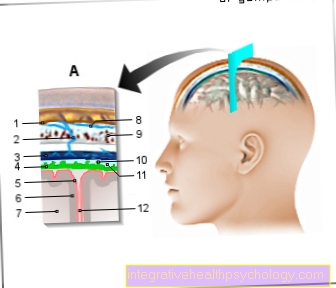






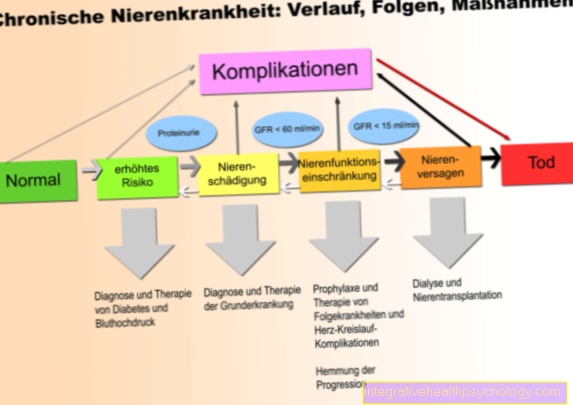
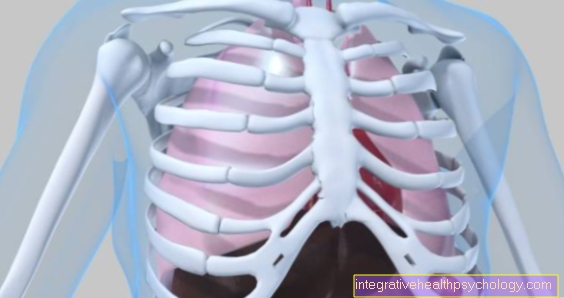
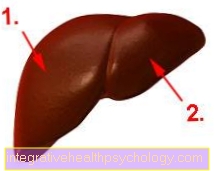
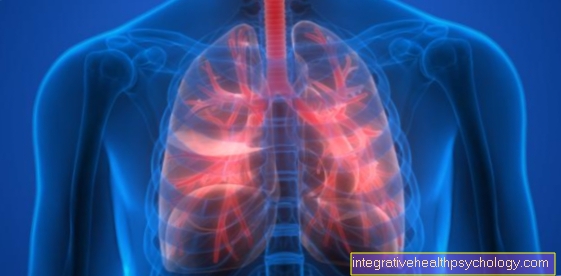
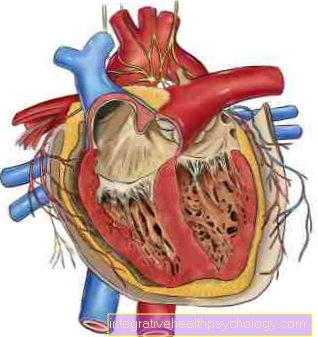
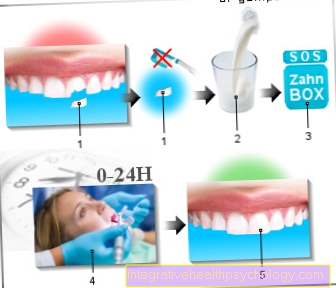






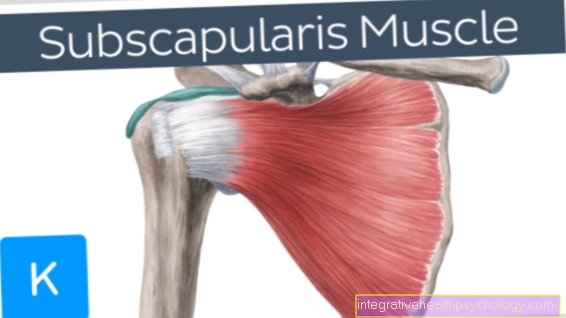




.jpg)
